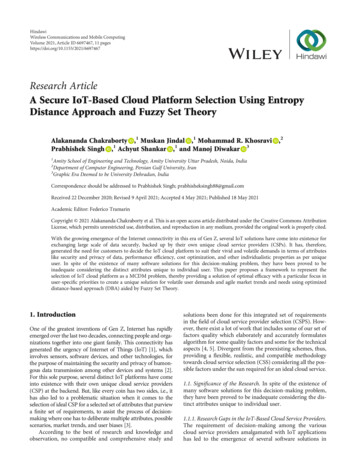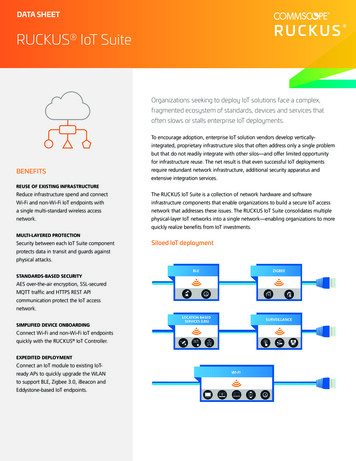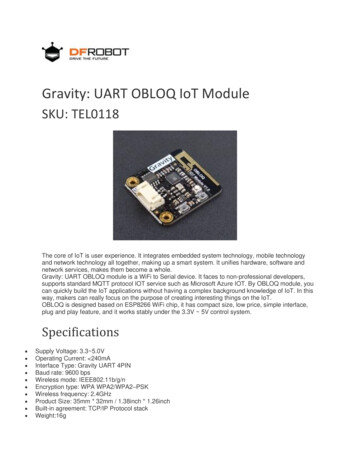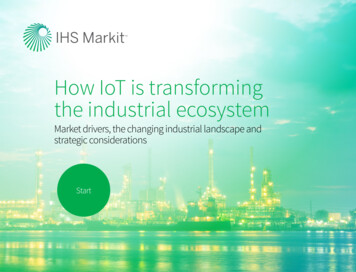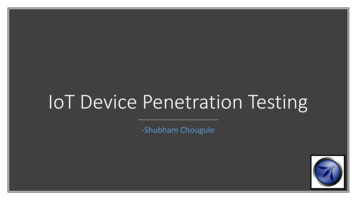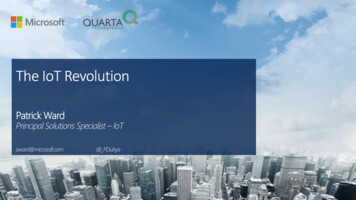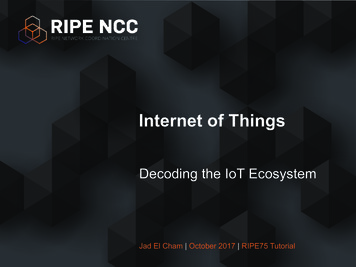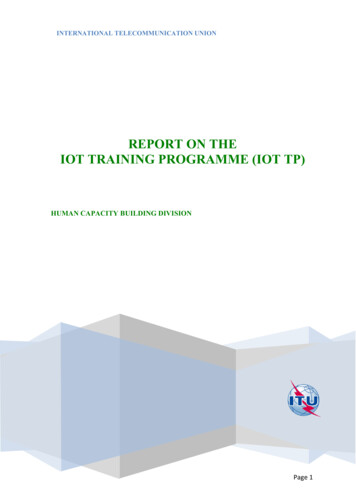
Transcription
INTERNATIONAL TELECOMMUNICATION UNIONREPORT ON THEIOT TRAINING PROGRAMME (IOT TP)HUMAN CAPACITY BUILDING DIVISIONPage 1
TABLE OF CONTENTSEXECUTIVE SUMMARY .41BACKGROUND AND JUSTIFICATION.51.1The role of an IoT Training Programme .51.2Overview of existing study resources and courses on IoT.71.3conclusions from analysing existing training and certification options .101.4Choice of immersion levels and professional specialization for the IOT TP .112THE IoT TP CONCEPT AND PROGRAMME OUTLINE .122.1Target audiences .122.2Course Structure .122.3Course Delivery Options .172.4Partner Institutions .173OVERVIEW MODULE .194FOUNDATION MODULES .204.1Foundation Module 1: Introduction to The Internet of Things .204.2Foundation Module 2: Standards, Architectures and Interoperability .224.3Foundation Module 3: Regulation Pertaining to the IoT .244.4Foundation Module 4: Design & Functioning of Wireless IoT Technologies.264.5Foundation Module 5: Physical IoT Infrastructure: From Device to Cloud .284.6Foundation Module 6: IoT Data Security, Privacy and Trust .304.7Foundation Module 7: Introduction to IoT Data Science .324.8Foundation Module 8: Global IoT Use Cases .345ADVANCED MODULES.365.1Advanced Module 1: Understanding & Designing Sensor Electronics .365.2Advanced Module 2: Advanced Wireless IoT Design in 5G .375.3Advanced Module 3: Designing & Programming of the Web of Things .405.4Advanced Module 4: AI and Machine Learning for IoT Big Data .415.5Advanced Module 5: Social & Ethical Implications and Case Studies .435.6Advanced Module 6: Business Models & Case Study Implications .455.7Advanced Module 7: IoT Entrepreneurship.476MASTER THESIS .50Page 2
7SETTING UP THE COURSE AND PREPARING SYLLABUSES .517.1Possible Contributing Institutions And Experts .517.2Remaining Time Required To Set Up The IOT TP .528PRINCIPLES OF STUDENT ASSESSMENT AND GRADING .539CONCLUSIONS .55Page 3
EXECUTIVE SUMMARYThis report describes the structure and content of a proposed Training Programme (TP) onthe Internet of Things (IoT) to be made available to the ITU membership for training andeducational purposes. The beneficiaries of the TP are expected to be academia, industry,regulatory bodies, government organisations and telecom providers.The TP has a modular structure and each module takes between 4 and 5 weeks for the studentto complete, including the final assessment per module. The option of an MSc Thesis is alsooffered.The modules described cover the entire area of the Internet of Things pertinent to the ITU.Notably, the TP deals with IoT standards, architectures, protocols, interoperability, devices,wireless connectivity technologies, cloud, security, privacy, trust, artificial intelligence, bigdata, ethical issues, business models and case studies; as well as IoT entrepreneurship.The eight Foundation Modules introduce above topics whilst providing students with asufficient level of technical detail. Out of these eight modules, at least six have to be takenand the first five are compulsory. Upon a successful completion of the Foundation Modules,verified by means of a test at the end of each of the taken modules, an ITU Foundational IoTCertificate will be issued to the student.Seven Advanced Modules provide the student with a much greater depth of understandingand more practical experience in each subject area. To obtain the ITU Advanced IoTCertificate, students needs to take at least four Advanced Modules and have successfullypassed the respective module tests.The Master Thesis can only be started after a successful completion of the Advanced IoTCertificate. The thesis ought to be assessed by an external body accredited to offer degreesat MSc level. A successful completion of such an assessment yields the Internet of ThingsMSc.The Advanced IoT Certificate course should ideally be taken after completion of theFoundational IoT Certificate; however, for those skilled in the arts, an entry test will be offeredwhich is modular in design and allowing the student to only take those modules in thefoundational course which the student failed.The designed TP would complement the existing professional training options and promotecommon education and design approaches. Due to the resources held by the ITU and partnerinstitutions, and the constant updating that should be possible due to on-going activities inthe three ITU sectors, the TP should be able to establish itself as the “gold standard” oftraining in the IoT arena.Note: To ensure viability, the format of this report was based on the successful ITU SpectrumManagement Training Programme.Page 4
1BACKGROUND AND JUSTIFICATION1.1 THE ROLE OF AN IOT TRAINING PROGRAMMEConnecting devices to the Internet is not a new idea: a toaster was connected to the networkin 1990 and users could interact with it via a web interface. Since then, industry, utilities andtrucking and logistics companies have all begun connecting their machines and assets tovarious systems and to each other. The actual phrase "The Internet of Things (IoT)" has beencoined in 1999 by Kevin Ashton of MIT in a presentation to Procter & Gamble. In the lastcouple of years ubiquitous connectivity, widespread adoption of IP, miniaturization, the riseof cloud computing and advances of data analytics have created the conditions for a dramaticgrowth of IoT. Cisco predicts that there will be billions connected devices by 2020.In 2012 the ITU defined IoT in Recommendation ITU-T Y.2060 as:“A global infrastructure for the information society, enabling advanced services byinterconnecting (physical and virtual) things based on existing and evolving interoperableinformation and communication technologies. A device is a piece of equipment with themandatory capabilities of communication and optional capabilities of sensing, actuation, datacapture, data storage and data processing. The devices collect various kinds of informationand provide it to the information and communication networks for further processing. Somedevices also execute operations based on information received from the information andcommunication networks.”This new technology has the potential to change the world, just as the Internet did; maybeeven more so. IoT is based on Next Generation Networks to communicate the huge amountof data gathered from the physical world. Furthermore, the availability of Big Data can beleveraged to make inferences about many phenomena and take corrective actions to mitigateunwanted effects. In addition to applications in cities and in industries, IoT can greatly benefitpopulations in Developing Countries: food safety can be checked, water quality can bemonitored, air quality can be measured, landslides can be detected and mosquitoes can becounted in cities in real time.The standardization activities for IoT is being conducted through the ITU-T Study Group 20 onInternet of Things and smart cities and communities. This study group was created in June2015 and develops international standards aimed at implementing IoT and smart cities andcommunities and promoting interoperability and transparency. The foundations of this StudyGroup are provided by ITU-T's experience in the development of IoT standards and thefindings of the ITU-T Focus Group on Smart Sustainable Cities (FG-SSC), which concluded itsactivities in May 2015 with the release of 21 technical reports and specifications.The role of IoT in smart cities is also explored within the global initiative United for SmartSustainable Cities, launched by ITU and UNECE in May 2016. This initiative is supported by 16United Nations agencies and programmes.The proposed Training Programme on Internet of Things aims at developing experts that areable to plan, design and maintain IoT systems with a special focus on applications, andadopting a problem-solving methodology.Page 5
Formal academic certification in collaboration with Centres of Excellence and other ITUAcademy partners in IoT worldwide would increase the appeal of this Training Programme. Ifthe Programme provided an equivalent qualification to a Master’s (MSc) degree, it wouldoffer to employers a clear benchmark reference, simplifying the process of recruitment whileat the same time facilitating the mobility of IoT professionals.Page 6
1.2 OVERVIEW OF EXISTING STUDY RESOURCES AND COURSES ON IOT1.2.1 Written SourcesWritten texts in the form of online and offline sources can be used by participants to augmentthe training material contents. The following are examples from ITU and from other sources(as retrieved on 27 March 2017), and should be extensively used within all modules:Published by ITU-T:Recommendation ITU-T Y.2060: Overview of the Internet of things (IoT), aspx?rec y.2060Unleashing the potential of the Internet of Things, 2016, mendation ITU-T Y.2063, Framework of the web of things, et of Things Global Standards Initiative, 2015, spxShaping smarter and more sustainable cities: Striving for sustainable developmentgoals, 2016, http://wftp3.itu.int/pub/epub rxpress.htmlWTSA Resolution 98 – Enhancing the standardization of Internet of things and smartcities and communities for global development, 2016,https://www.itu.int/dms nting ITU-T International Standards to Shape Smart Sustainable Cities: TheCase of Dubai, 2016, 016DubaiCase/index.htmlIUnited for Smart Sustainable Cities: Striving for Sustainable Development Goals, 2016,http://wftp3.itu.int/pub/epub shared/TSB/2016-ITUT-SSCBrochure/en/index.html#p 1Joint Coordination Activity on Internet of Things and Smart Cities and Communities(JCA-IoT and SC&C), available efault.aspxITU-T SG20: IoT and smart cities and communities (SC&C), available 17-2020/20/Pages/default.aspxPublished by ITU-R:Page 7
Resolution ITU-R 66: Studies related to wireless systems and applications for thedevelopment of the Internet of Things, 2015, http://www.itu.int/pub/R-RES-R.66-2015Resolution ITU-R 54-2: Studies to achieve harmonization for short-range devices, shed by ITU-D:The Internet of Things: data for development. In Measuring the Information SocietyReport 2015, 2015, pp. 147-171. ations/mis2015.aspxPublished by ITU General Secretariat:ITU Internet Reports 2005: The Internet of Things, 2005, http://www.itu.int/pub/SPOL-IR.IT-2005/eHarnessing the Internet of Things for Global 16,Published outside ITU:Manyika, J., Chui, M., Bisson, P., Woetzel, J., Dobbs, R., Bughin, J. and Aharon, D., 2015.The Internet of Things: Mapping the Value Beyond the Hype. McKinsey Global Institute.Evans, D., 2011. The Internet of Things. How the Next Evolution of the Internet .com/c/dam/en us/about/ac79/docs/innov/IoT IBSG 0411FINAL.pdf.Accessed 7 Apr. 2017.Goldman Sachs, 2014. IoT primer. The Internet of Things: Making sense of the nking/outlook/internet-ofthings/iot-report.pdf. Accessed 7 Apr. 2017.Walport, M., 2014. The Internet of Things: making the most of the Second ploads/attachment .pdf. Accessed 7 Apr. 2017.Rose, K., Eldridge, S. and Chapin, L., 2015. The internet of things: An overview. TheInternet Society (ISOC), pp.1-50. cessed 7 Apr. g/technologiesclusters/clusters/connecting-things. Accessed 30 Mar. 2017.Page 8
Eclipse.org, 2016. Eclipse IoT Working Group. https://iot.eclipse.org/working-group/.Accessed 30 Mar. 2017.GSMA, 2016. GSMA: the impact of the Internet of Things. The Connected ds/15625-Connected-LivingReport.pdf. Accessed 30 Mar. 2017.IEEE.org, 2017. IEEE Internet of Things. http://iot.ieee.org/. Accessed 30 Mar. 2017.1.2.2 IoT CoursesITU Asia-Pacific CoE Program:Developing the ICT ecosystem to harness Internet of Things, 13-15 December 2016,Bangkok, raining.aspxOnline training courses:Fog Networks and the Internet of ThingsPrinceton University via Coursera, available rsera-fog-networks-and-theinternet-of-thingsThe Internet of ThingsKing’s College London, available urelearn-the-internet-of-thingsInternet of Things: How did we get here?University of California, San Diego via Coursera, available rsera-internet-of-things-how-didwe-get-hereHow the Internet of Things and Smart Services Will Change Societyvia openSAP, available online:https://open.sap.com/courses/iot1Internet of Things: Communication TechnologiesUniversity of California, San Diego via Coursera, available Internet of Things: Roadmap to a Connected WorldMIT Professional Education, available grams/courses/IoT/Page 9
IoT for ExecutivesExpertfy, available t-for-executivesUniversity Courses:Malmo University, SwedenComputer Science: Internet of Things, Master's Course, available y of Salamanca, SpainMaster in the Internet of Things, available online:http://iot.usal.es/University of Oxford, UKData Science for the Internet of Things (IoT), available ience-for-the-internet-of-things-iotQueen Mary University of London, UKMSc in Internet of Things, available oursefinder/courses/173148.htmlCIFF Business School, SpainMaster in Internet of Things (IoT), available hings.htmlRoyal Holloway, University of London, UKMasters in The Internet of Things, available et-of-things/iot.aspxUniversity of the West of Scotland, UKMSc Internet of Things (IoT), available online:http://www.uws.ac.uk/postgraduate/internet of things (iot)/Waterford Institute of Technology, IrelandBSc (Hons) in the Internet of Things, available artment of computing maths physics/bsc-hons-in-the-internet-of-things1.3 CONCLUSIONS FROM ANALYSING EXISTING TRAINING AND CERTIFICATIONOPTIONSAlthough several Universities already offer courses (at MSc and BSc levels) on subjects relatedto the IoT, a training programme organised by the ITU specifically on IoT would complementPage 10
the existing professional training options and promote common approaches. The IoT TPshould meet the following criteria: Important is to scout for tutors who have a proven track record in the respective fieldof teaching; the reason this is not so easy is because the IoT is a fairly new area (thusshortage of skills) and very hyped area (thus exaggeration of skills). The program should not be focused on a national agenda (e.g. only US or only UK) butbe truly international in scoping, case studies, applications, etc; it is important tohighlight the global capabilities of the IoT whilst also highlighting the nationalparticularities. It should be based on the latest IoT standards and regulations as defined by ITU andby other international and industrial organizations. While other programs cover IoT ingeneral, few focus their attention on regulations which we believe could be a massivedifferentiator for the ITU TP. The case studies and applications should also be geared towards Developing Countrieswhere the potential of the IoT is very large. The IoT TP, when fully completed, should aim at being recognized as an equivalent toa Master’s degree. The TP should offer a broader and deeper professional knowledge with strongerengagement than possible through exclusively online courses. As the TP is organised by the ITU, particular attention should be given to regulation,standards and technical planning pertaining to the IoT. The topic of ethical issues, including data privacy laws, related to IoT should beincluded in the TP, as this aspect is gaining more and more attention.1.4 CHOICE OF IMMERSION LEVELS AND PROFESSIONAL SPECIALIZATION FORTHE IOT TPIt is likely that an ITU training programme on IoT would interest people with differentacademic and professional backgrounds and with different work experience. Two entry levelsto the IoT TP are therefore proposed:1. Foundation level, for participants with little or no prior work experience in orknowledge about IoT. Foundation level modules will provide the basic concepts aboutIoT and related technologies. Successful completion of a set of foundation moduleswould lead to a certificate but not a full diploma equivalent to an MSc.2. Advanced level. For admission at this level the participant would need to have passedthe Foundation level successfully or, alternatively, demonstrate an equivalentunderstanding of the principles by means of an entry level examination/project.Page 11
2 THE IOT TP CONCEPT AND PROGRAMME OUTLINEThe IoT TP is designed to fit within the European Credit Transfer and Accumulation System(ECTS). ECTS is a standard for comparing the study attainment and performance of studentsof higher education across the European Union (EU) and other European countries. ECTScredits are awarded for successfully completed studies. One academic year corresponds to60 ECTS credits that are equivalent to 1500–1800 hours of study in all countries irrespectiveof qualification type, and so can facilitate transfer and progression throughout the EU. Theobjective will be to extend this globally for the IoT TP. Formal (external) assessment would beneeded for the qualification to be recognised externally, as described later.The IoT TP is designed to be modular, with each successfully completed module requiringaround 125 hours of study and generating 5 ECTS credits. 10 modules and a Master Thesiswould therefore be required to complete a course of 60 ECTS credits and receive a Master’sdegree. The duration is designed to be around one calendar year for participants aiming totake the complete course, but this can be extended to allow part time study.2.1 TARGET AUDIENCESThe IoT TP could be taken by any professional who has previously graduated with a first-leveluniversity degree (e.g. BSc). Students entering the IoT TP could be from different institutionallevels, from technical to managerial, and from different backgrounds (engineering, legal,regulatory, economic, etc.). Students wishing to join at the Advanced Level would need tohave at least one year of professional experience in the field of IoT and pass an entranceexamination and/or submit a project or essay to assess their level of knowledge. A committeewould be in charge of evaluating the examination/essay, taking into account culturaldifferences.The IoT TP is designed for anyone wishing to enhance their professional knowledge in thefield of IoT, for example:-Electronical engineersTelecommunications engineersComputer scientistsPolicy makers and RegulatorsTelecom OperatorsNetworks Operators2.2 COURSE STRUCTUREAs the IoT TP is mainly addressed to working professionals, it should consist of a sequence ofmodules spread over a calendar year. A modular structure would allow new modules to beadded or existing modules to be changed readily. A modular structure also has the followingbenefits:1. They are a convenient way to combine study options with daily work commitments,as students would only need to focus on one study topic at a time;Page 12
2. They simplify the logistics by minimizing the coordination needed between differentpartner institutions: only the organization managing a particular study module wouldbe responsible for daily operations in any given time period;3. Time commitments are more predictable for teaching staff (assuming each tutor isassigned the same module(s) in successive years and each module is offered annuallyin the same time-frame);Module durations of four/five weeks have been used throughout, which are short enough forfocused study of one topic but long enough to give instructors flexibility in planning theirsyllabuses. This also allows for a succession of different modules to fit within one year. Periodsof self-directed study may fit in with holidays, major industry events, work-related travel, etc.As per Figure 1, there are Foundation Modules underpinning the Foundational IoT Certificateat 30 ECTS credits which are described in great depth in Section 4; and there are AdvancedModules underpinning the Advanced IoT Certificate at 20 ECTS credits which are describedin Section 5. Finally, in Section 6, the Master Thesis at 10 ECTS credits is detailed which canbe taken by those with an Advanced Certificate and yields the Internet of Things MSc.Only taking the Fundamental Modules yields a Foundational IoT Certificate. Out of the 8modules, at least 6 have to be taken with 5 ECTS credits each. The first 5 are compulsory,whilst the student can choose at least 1 from FM6-FM8 which are optional.To obtain the Advanced IoT Certificate, one needs to take at least 4 Advanced Modules at 5ECTS credits each. All of the offered 7 Advanced Modules are optional, and only looselyrelated allowing a completely independent choice of modules.The Internet of Things MSc can only be started after the Advanced IoT Certificate. TheAdvanced IoT Certificate course should ideally be taken after completion of the FoundationalIoT Certificate; however, for those skilled in the subject area, an entry test will be offeredwhich is modular in design and allowing the student to only take those modules in thefoundational course which the student failed.The proposed composition of the IoT TP modules is discussed in greater details in subsequentSections 3-5.Page 13
Page 14
Figure 1. IoT Training Programme Scheme.Page 15
OM: Overview un1 2 3 4 5 6 7 8 9 10 11 12 13 14 15 16 17 18 19 20 21 22 23 24 25 26 27 28 29 30 31 32 33 34 35 36 37 38 39 40 41 42 43 44 45 46 47 48 49 50 51 52 53 54 55 56 57 58 59 60 61 62 63 64 65 66 67 68 69 70FM1: Introduction to the Internet of ThingsFM2: Standards, Architectures and InteroperabilityFM3: Regulation Pertaining to the IoTFM4: Design & Functioning of Wireless IoT TechnologiesFM5: Physical IoT Infrastructure: from Devices to CloudFM6: IoT Data Security, Privacy and TrustFM7: Introduction to IoT Data ScienceFM8: Global IoT Use CasesAM1: Understanding & Designing Sensor ElectronicsAM2: Advanced Wireless IoT Design in 5GAM3: Designing & Programming of the Web of ThingsAM4: AI and Machine Learning for IoT Big DataAM5: Social & Ethical Implications and Case StudiesAM6: Business Models and Case Study ImplementationsAM7: IoT Entrepreneurshipbreak (eg summer)MT: Master ThesisFigure 2. Approximate Gantt chart of the IoT TP. Important to note is that the first and last weeks of each module generally require physical presenceand/or some form of increased interaction where likely many agendas need to be aligned. It is therefore important to keep these weeks orthogonal andnot double schedule them. In the Gantt they are marked in dark green and at any week only 1 dark green should be present. The light green are self studyand the students should be able to study in parallel at their own pace.Page 16
2.3 COURSE DELIVERY OPTIONSThe IoT TP structure is presented in Figure 1 and a suggestion on the timing Gantt in Figure 2.It is based on the assumption that Foundation modules will be primarily classroom driven,with face-to-face tuition, whereas Advanced modules could rely primarily on e-learningincluding some real-time, web-based seminars with experienced tutors to introduce thesubjects, set a structure for the module, present best-practice case studies and set challengesfor the students. The emphasis would be on actively teaching the well-established generalsubjects (Foundation modules) in classroom situations, drawing on pre-preparedpresentations and reference materials, while the Advanced modules could rely more on selfpaced e-learning, including in-depth research and study of specialized literature sources(albeit some instructor-led teaching is required due to the depth of the topic). The flexibilityof Advanced modules oriented toward instructor-led self-study would be especially useful ifthe student’s organization requires some special type of knowledge in a given subject.Consequently, all modules might benefit from exploiting different delivery modes adapted bythe tutor. For example, the time allocated to a module might be divided between: Classroom teaching and physically attended seminars and workshops. Case studies and practical exercises which should be included in all modules. Instructor-led remote lectures (live or pre-recorded). Self-study of textbooks and reference material.Classroom instruction could be coordinated by the ITU Academy and conducted at ITUCentres of Excellence or other partner institutions.2.4 PARTNER INSTITUTIONSThe ITU Academy should become a convenient coordinating point for devising and thenimplementing the IoT TP. International partners would be involved in preparing teachingcontent, decide how and what to test for in the certification procedure, design entry-levelexaminations that could confer academic credit for work experience, and eventuallydetermine how to staff, deliver and manage the training programme.Suitable institutional partners could be found among the following categories: ITU BDT, together with the ITU Academy, as coordinator; ITU-T and its study groups (e.g. those dealing with relevant technological standards); Organizations participating in the running of the ITU Centres of Excellence (CoEs) invarious regions; Centres of Excellence in IoT worldwide (such as the CoE in IoT in Rwanda, the CoE inIoT in Colombia, etc); Academic members of the ITU; and Universities and Research Centres.All potential partners should be consulted in order to gauge their interest in an IoT TP, bothwith regard to the possibility of their participating in training and with regard to the potentialdemand for certified specialists. The level of demand will influence the number of studentsPage 17
accepted onto the programme, which will in turn influence the budget and staffingrequirements. These consultations will provide a better understanding of the types ofinstitution that are interested in participating and their level of engagement, as well as theoverall scale of the undertaking, which will help in forming a consortium.Another important consideration in terms of support and participation should be theestablishment of a pool of well-qualified IoT experts. These experts may be involved first ofall in the process of developing the teaching content and assessment exams; some maycontinue their engagement in the delivery of the classroom-based modules and remotetutoring of students, as well as supervision of their progress and eventual Master’s thesis.Page 18
3OVERVIEW MODULEThe Overview Module that precedes the course structure shown in Figure 1 is describe
Internet of Things and smart cities and communities. This study group was created in June . The Internet of Things: Mapping the Value Beyond the Hype. McKinsey Global Institute. Evans, D., 2011. The Internet of Things. How the Next Evolution of the Internet Is Changing Everything. CISCO I.B.S.G.


